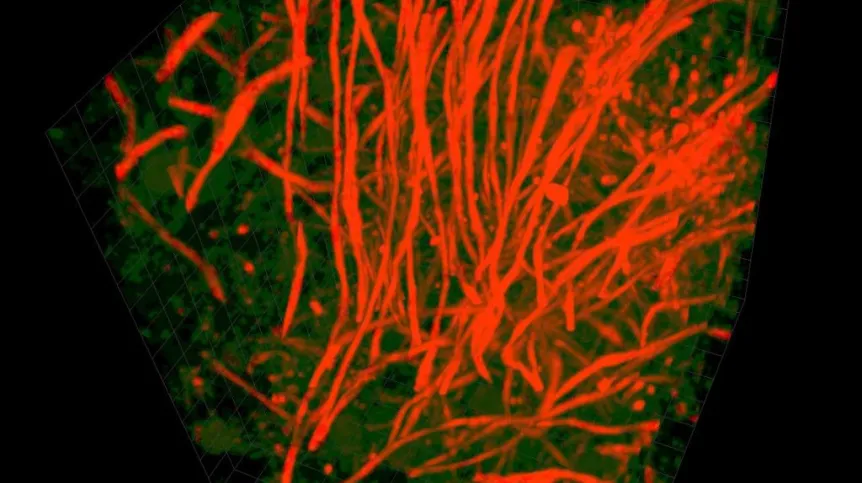
Do children with dyslexia have a slightly different structure of the brain than their peers? What chemical reactions cause the immune system to promote the development of malignant tumours of the brain? Why are some events so firmly imprinted in our memory? Researchers from newly built Neurobiology Center of the Nencki Institute in Warsaw already have answers to these questions.
Neurobiology Center of the Nencki Institute, officially opened in mid-November last year, already has the first results and scientific publications. Research topics included dyslexia in children, compassion pain, memory mechanisms , and chemical signaling pathways malignant brain tumors use to reprogram the cells of the human immune system, as announced in the release sent to PAP.
The Neurobiology Center carries out research (using magnetic resonance imaging scanner) on the dyslexia in children. Scientists are trying to determine the link between the naming and attention deficit and anatomic features of certain brain structures such as the cerebellum and parietal cortex. The results of previous research, recently published in the journal "Brain Structure & Function" will be used to develop better methods of diagnosis of dyslexia, and in the future will probably help to develop appropriate therapies.
The new center has carried out a complete chemical analysis of the signalling pathways which malignant brain tumours use to reprogram human immune cells and make them cooperate. Modern large scale methods allowed to study the changes in the expression not of individual genes, but all genes simultaneously. The publication on the subject has been published in the neurobiological journal "Glia".
Researchers have also completed work on the database of the mechanisms of reading the genetic information (gene regulation) in the whole genome of three species: mouse, rat and human. Database of Nencki genomic website ( www.nenckigenomics.org) is integrated with other research databases. It contains a set of data and tools necessary to determine the "read" mechanism of each gene based on the gene sequence and knowledge about how its regulation in different cells. The description of this unique database is presented in the prestigious journal "Database", published by Oxford Press.
The Neurobiology Center has created a database of standardized NAPS ( Nencki Affective Picture System) images. Each of more than 1,350 photographs depicting people, animals, landscapes and objects, was evaluated by over 200 people. Researchers collected behavioural data allowing to predict whether an image would be perceived as positive/negative, stimulating/relaxing, etc. NAPS (www.naps.nencki.gov.pl) is the first such database in Europe, adapted to the specifics of our culture.
NAPS database is now used to study remembering. By showing volunteers the images from the database and observing the changes in the activity of different centres in the brain, scientists from the Neurobiology Center are able to assess whether the subject will remember the image in a few weeks or not. The results of these experiments will help determine why certain situations are so effectively imprinted in the memory. The long-term aim of the research is to understand how the pathological mechanisms of memory and attention play a major role in post-traumatic stress.
In addition to scientific research, the Centre for Neurobiology will assist in creating a favourable and attractive environment for the development of the most talented researchers from Europe and the world, specialising in neurobiology, biochemistry and molecular biology. "The investments associated with the Neurobiology Center, latest research and measuring equipment, and above all, excellent staff are our strong advantages. We hope that by combining them, in a decade the Nencki Institute will become one of the leading research centres in Europe" - said Prof. Adam Szewczyk , Director of the Nencki Institute.
The Nencki Institute Neurobiology Center (Centrum Neurobiologii Instytutu Nenckiego, CNIN) is part of key European project CePT - Centre for Preclinical Research and Technology. The construction cost of CNIN amounted to 52 million zlotys (15 percent of the value of CePT). Construction of the Neurobiology Centre allowed the Nencki Institute to take a leading role in prestigious European projects, including the EuroBioImaging of the Roadmap of the European Strategy Forum on Research Infrastructures (ESFRI).
The Neurobiology Center currently has five environmental laboratories: Laboratory of Molecular Neurobiology, Laboratory of Imaging Tissue Structure and Function, Laboratory of Animal Models, Laboratory of Brain Imaging and the Laboratory of Preclinical Testing of Higher Standard.
The CePT project , with a budget of over 388 million zlotys, is the largest bio-medical and biotechnology project in Central and Eastern Europe. The project, of which Nencki Institute is one of several participants, involves building a group of related environmental laboratories in the Warsaw district of Ochota, integrating research and an implementation of many scientific institutions.
PAP - Science and Scholarship in Poland
lt/ agt/
tr. RL













